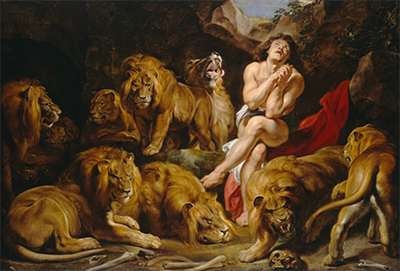Peter Paul Rubens takes inspiration from the Book of Daniel, passage 6:1–28 in order to produce this huge, uplifting painting that is now owned by the National Gallery of Art in Washington, DC, USA.
To consider how impressed the people of the day were by this particular artwork, Rubens was later offered 80 classical sculptures, in return for this and several other of his own artworks. He accepted this offer and extended his art collection significantly in this one single deal. It was not unusual for masters to collect the work of others, often across a variety of different mediums as they looked to expand their knowledge and understanding of other artists. Rembrandt van Rijn famously teetered on the verge of bankruptcy due to his continual desire to expand an impressive collection of Dutch and Italian art.
The biblical tale speaks of prophet Daniel provoking jealousy from other ministers who forced him into a lion's den as a result. Some have claimed that the punishment was really delivered from froPersian king Darius I The Great who was angry at Daniel worshipping God rather than him. The scene found in this painting is where Darius removes a covering rock and, to his surprise, discover that Daniel is indeed still alive. This kind of miraculous recovery or survival continues throughout religious scripture as a means to inspire and empower its readers. The painting is dated from 1614-1616 and would have taken Rubens considerable time to complete when considering the amount of detail across this composition that is over three metres wide by two metres tall.
The painting appears to capture Daniel praying to God for help is escaping his perilous situation, which is finally delivered the next morning when the den is opened again and he is released. One interesting aspect of Rubens' depiction, with many other artists having also created their own versions, is that he made use of a very youthful looking Daniel, despite biblical tales placing him at around 80 years of age at this time - clearly some artistic licence had been used in that regard.




